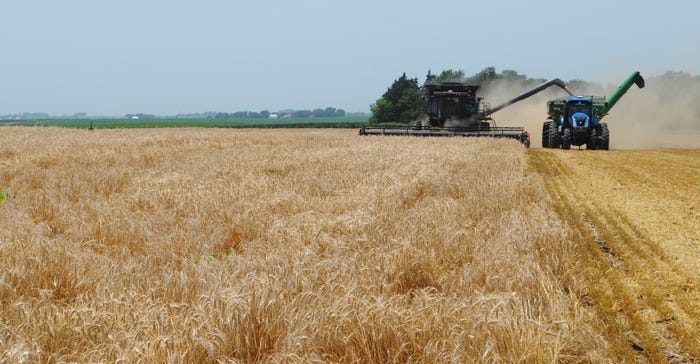
His neighbors were all spraying soybeans or shooting off fireworks on July 4, but this year Chad Christianson and buddy Robert Mulliken were in the field harvesting wheat to celebrate a hot, muggy Independence Day north of Fremont, Neb.
For Christianson, wheat is something new. There probably hasn’t been wheat on his farm in more than 60 years.
However, Christianson is sold on the soil health benefits of double cropping and keeping a growing root in the soil as long as possible. But to accomplish that, it also has to pay the bills. That’s why Christianson made the move to add wheat to his seed corn-soybean rotation, and is trying to double-crop soybeans after wheat harvest.
Last fall, Christianson planted hard red winter wheat for the first time after seed corn harvest in September. He planted WB-Cedar, a broadly adapted variety with excellent straw strength, good winter-hardiness and solid test weight. It is also the earliest-maturity wheat with a good performance record in eastern Nebraska trials, with good Hessian fly resistance.
Wheat is a unique crop for east-central Nebraska, but it is one that Dodge County Nebraska Extension educator Nathan Mueller believes can help boost profits and soil health.
“This intensified crop rotation adds more months to the year with an active root system,” Mueller says. “Based on regional research, we know that wheat added to the corn-soybean rotation will improve water aggregate stability over time,” he adds. “Water stable aggregates are one of the most sensitive and best single indicators of soil physical health, but are also a positive soil physical property for biological health, too.”
Timing is everything. They are pushing the growing season limits in east-central Nebraska to pull off a rotation of irrigated seed corn and winter wheat, double-cropped with soybeans, Mueller says. “Timely fall wheat planting the second half of September compared to our normal mid-October planted wheat after soybeans is needed. This helps gain a few days towards an earlier wheat harvest.”
Nebraska Farmer stopped by Christianson’s wheat field during harvest. “We planted the winter wheat early last fall, but April this year was so cold, things didn’t get started this spring like we had hoped,” Christianson says. “If it had been a normal spring, we would have been combining this two weeks earlier.”
Although Christianson’s area experienced the coldest April on record since 1895, warmer May and June temperatures helped make up for the slow start.
As it worked out, harvest came on July 4, during a week when the area had experienced more than 5 inches of precipitation. Some of the wheat in the lower parts of the field lodged, so they harvested with an Agco combine and a Massey Ferguson draper header. Although some parts of the field were laying entirely flat, the draper head picked it up.
“Yield estimates before all the lodging were about 100 bushels per acre,” Christianson says. The result came out at 64.4 bushels per acre with 14.2 protein. The test weight was light due to lodging, canceling out any protein bonus, Christianson says.
“Lodging is always a concern with winter wheat because of severe thunderstorms in May and June,” Mueller says. “On average, good soil moisture in the spring leads to good vegetative growth during jointing and elongation. Early-planted wheat following seed corn is more likely to have more vegetative growth compared to later-planted wheat after soybeans,” he explains. “Nitrogen management, including rates and timing, can exacerbate the vegetative growth and lodging risk. Because soil nitrogen availability following seed corn can be variable, I recommend taking fall soil samples to help make nitrogen rate adjustments.”
Reducing erosion
Erosion control after seed corn production is another benefit of the system. “Winter wheat is a great soil erosion control crop as it protects soil during a critical time in May and June when we have frequent and high-intensity rainfall events,” Mueller says. “It can also help us manage problematic weeds such as marestail, waterhemp and Palmer amaranth.”
Christianson planted soybeans into wheat stubble four days after harvest on July 8. Mueller and Christianson utilized the Nebraska Extension SoyWater tool, which has phenology and a development model in it.
“We used SoyWater to assess planting dates, variety relative maturities and the date soybeans reach maturity along with using long-term weather data for Fremont to learn the first average fall freeze event to guide the selection on soybean maturity,” Mueller says. In the end, they settled on a 2.1 maturity Merschman LibertyLink soybean variety called Ute. If wheat harvest had taken place in mid-June as originally planned, Christianson looked at a soybean yield goal of 40 to 45 bushels per acre. Because of the late nature of soybean planting, he ratcheted his goal down to 30 bushels per acre.
“The weather may not cooperate some years, so be willing to move to Plan B, which might include a wheat cover crop instead of a cash crop or a cover crop instead of double crop soybeans due to significant weather delays,” Mueller says.
“This was supposed to be a learning year for us in this system,” Christianson says. “We definitely learned a few things that we can build on going into next year with this system.”
You can learn more about double-cropping winter wheat with soybeans by contacting Mueller at [email protected].
About the Author(s)
You May Also Like






